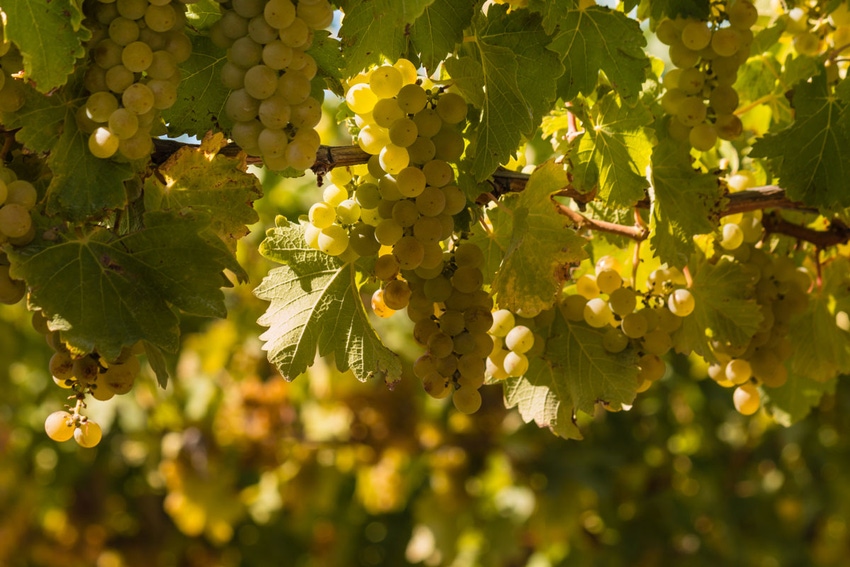
Bud break was underway in most of Lake County’s valley floor vineyards by the second week of April. Meanwhile, shoots in some vineyards on the higher, warmer hillsides had already grown to about 8 inches in length.
That’s in line with the new-normal pace of development in this part of the North Coast wine grape region, says Jonathan Walters, chairman of the Lake County Wine Grape Commission. However, growth rates in the vineyards he manages as director of farming for Brassfield Estate Winery were trailing behind by about seven to 10 days. The winery’s 267 acres of vineyards in the High Valley AVA range from an elevation of 1,800 feet on the valley floor to nearly 3,000 feet on the surrounding volcanic ridges.
He attributes the slower growth in his blocks to cooler temperatures in mid-March. “That’s a good thing,” he says. “It should help push our harvest back a little later, allowing for a longer hang time and improving fruit quality.”
The winery’s white varieties – Gewürztraminer, Pinot Gris, Riesling and Sauvignon Blanc – and Pinot Noir are grown exclusively on the valley floor. The blocks of the hardier red varieties, including Cabernet Sauvignon, Grenache, Malbec, Mourvedre, Petite Syrah, Syrah, Tempranillo and Zinfandel are located on the hillsides,
The field work is handled by two crews. They began removing suckers from the trunks and cordons in mid-April
The relatively high elevation tends to limit insect pressures in Lake County’s vineyards, Walters notes. “A lot of insects can’t survive our colder winters and the wide diurnal changes in temperatures, which may swing as much as 40 to 60 degrees F between daily highs and lows during the season,” he says. “Leafhopper populations vary, depending on the season. However, mites are a problem because of our rich, volcanic soils.”
This year, Walters plans to start irrigating his vineyards later than he has in some time.
Soil moisture levels in his fields are the highest he’s seen in at least three years, if not longer.
“All the reservoirs in the county are very full,” he says. “The amount of rain we’re received since last fall will allow us to delay the start of irrigation of our vineyards in the valley floor until the middle or end of June. We’ll begin irrigating our rocky, well-drained sites with little organic matter on the hillsides around the start of May. That’s also later than we have done in the past few years.”
To better determine when to begin each irrigation, Walters combines soil moisture probe readings with the use of infrared sensors and pressure chamber results to monitor the canopies for water stress.
Typically, frost, which is a threat only on the valley floor, remains a concern for growers here until around Mother’s Day. However, up until mid-April, valley vineyards have had frost no more than three nights this year. Walters recalls some years, when growers have turned on water for frost protection as many as nine or 10 times in the spring.
“We’ve had just one heavier frost and two light frosts this year, and each required no more than five or six hours of frost protection,” he said. “In some seasons, we may have to run our sprinklers during freezing temperatures that can persist for as long 10 hours at a time. This year, most of the water we’ve used for frost protection has drained back into the soil, minimizing the amount lost in runoff.”
Brassfield Estate Winery has been harvesting grapes mechanically for the past decade. Following the 2014 harvest, the winery purchased a new Pellenc Optimum 890 harvest. “It has an onboard sorter and picks the fruit with little or no material other than the grapes,” he says.
As part of his on-going efforts to produce better grapes more efficiently, Walters and his crew also tried out some other types of mechanized equipment during the past dormant season,
One was a new cane tying machine. “It’s a fantastic piece of equipment, and we’ll probably be using it more regularly,” he says.
They also tested three makes of mechanical pruners. One, in particular, stood out because of its better ergonomic features, more power and longer battery life, Walters notes.
However, even though it saves his crews wear and tear on their hands and muscles, he’s holding off any purchase decision for a while. “Some of our guys, who’ve been using hand shears for more than 20 years, are very skilled and can prune 800 vines a day, Walters says. “It took them some time to get used to doing the work with a machine. I’ll probably wait until the next generation of younger workers to start using the machines in our operations.”
Last year was another good season for Lake County growers, he says. As in other areas of the state, tonnage of Pinot Gris and Pinot Noir grapes harvested from Brassfield Estate Winery’s vineyards was down. However, yields of the winery’s other varieties were similar to their average over the past two to three years, Walters notes.
“Compared to other North Coast regions, wine grape production in Lake County is very consistent,” he says. “Our growers are finally getting the credit they deserve for their Cabernet Sauvignon, and our Lake County Sauvignon Blanc wines are some of the best in the state.”
About the Author(s)
You May Also Like




